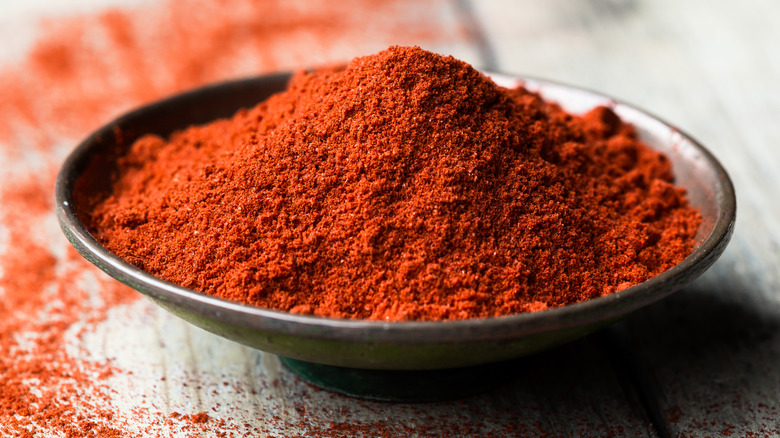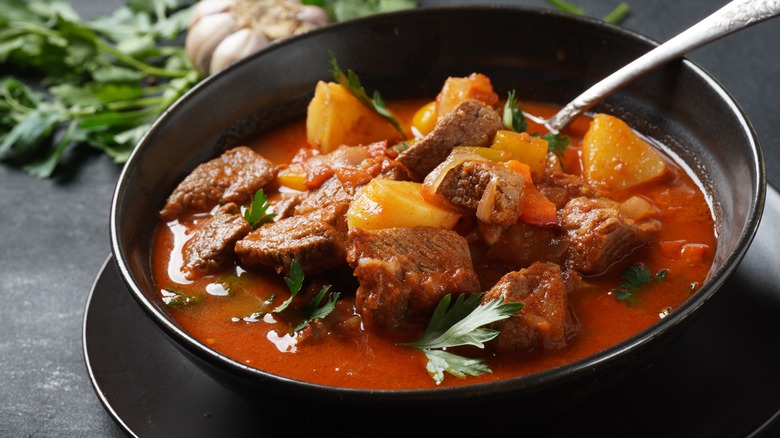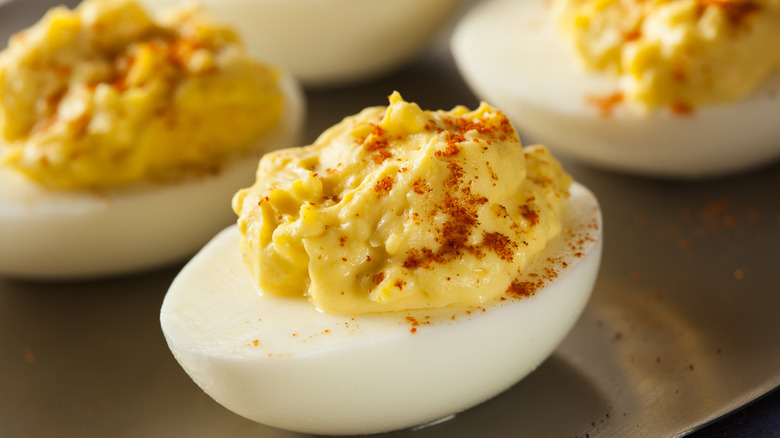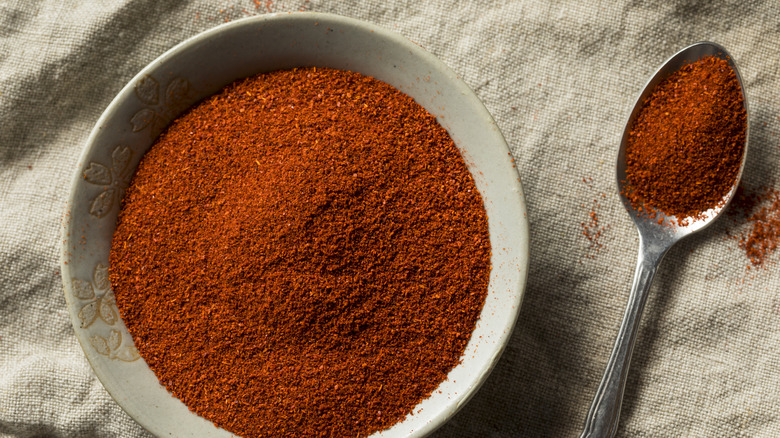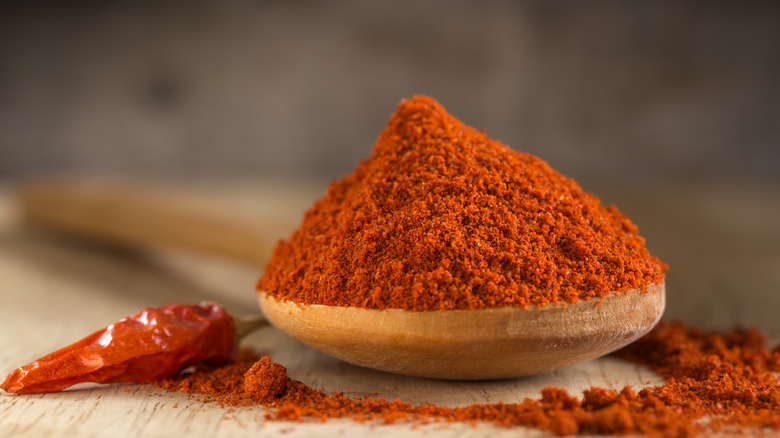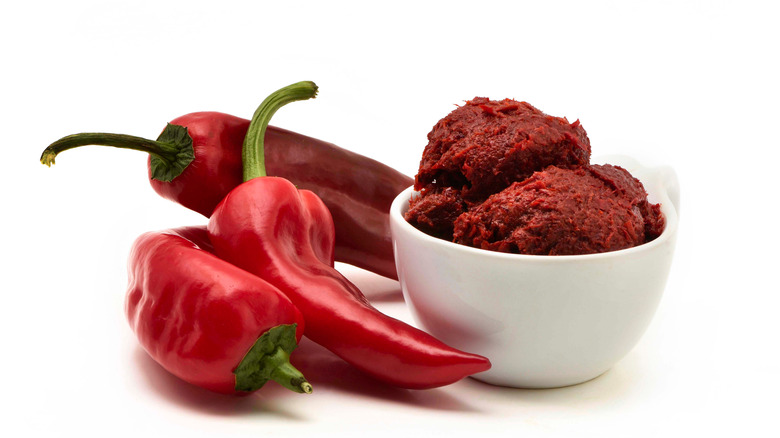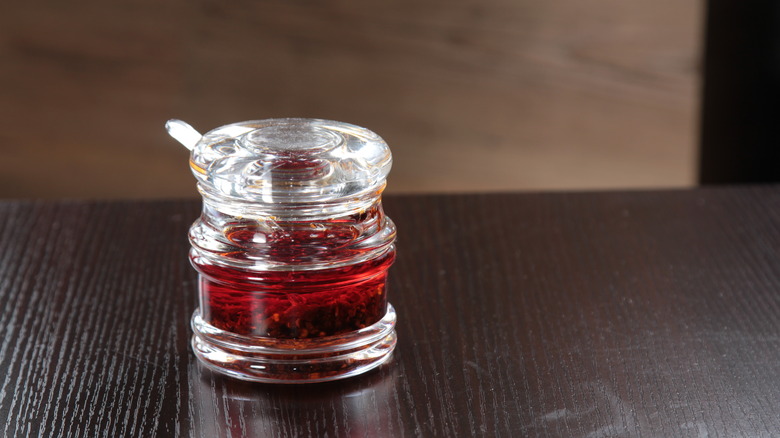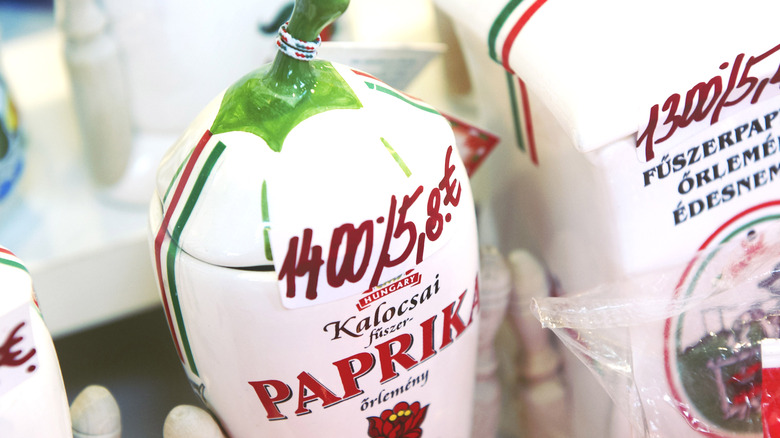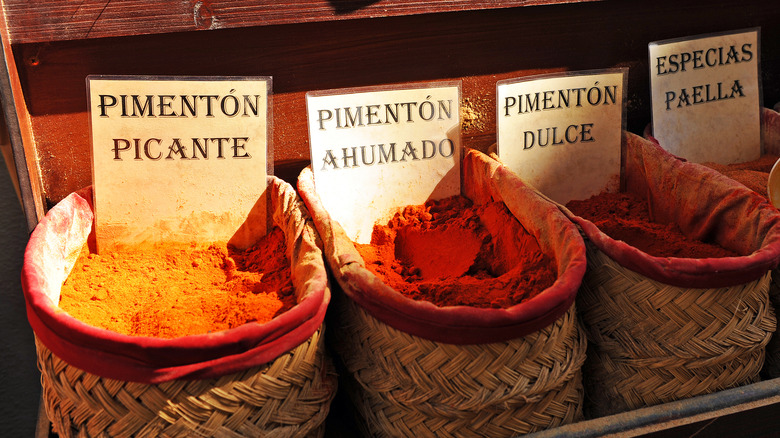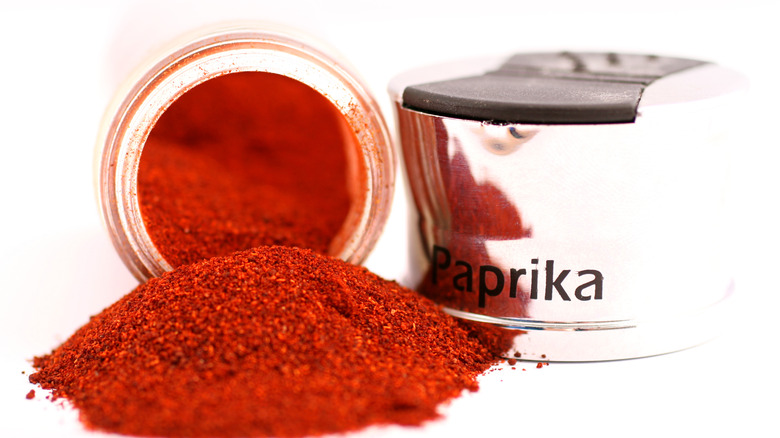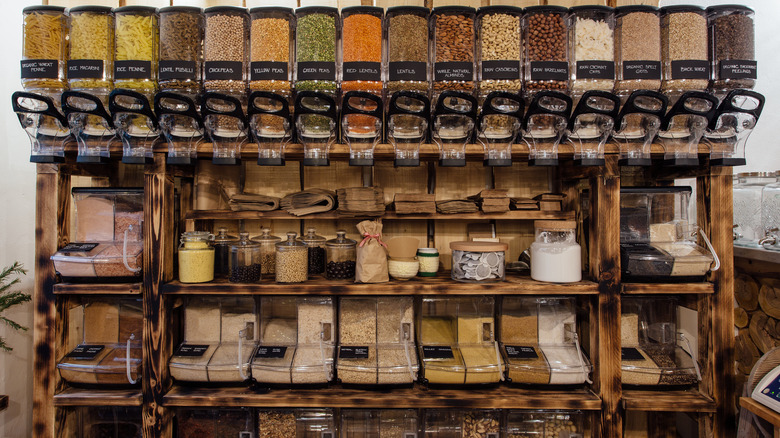The Ultimate Guide To Choosing The Perfect Paprika
We may receive a commission on purchases made from links.
If you are anything like us, you have at least one bottle of paprika on your spice rack or in your spice cabinet. And, like us, you may have found yourself wondering, at one point or another, what that spice actually is. According to the McCormick Science Institute, many types of pepper can be used to make paprika, though producers usually use sweet or bell peppers. To achieve the red color paprika is known for, the peppers must be fully ripe.
This vitamin C powerhouse has a surprisingly spicy origin. It is said that Christopher Columbus brought peppers back from the colonized Americas to Europe. Initially, 16th-century Europeans used these plants as decoration. Over time, the plants became milder, and people began to eat them. In 1569, Ottoman Turks brought paprika to Hungary, where it remains the national spice.
Today, there are multiple varieties of paprika from which to choose. So, how do you choose which type you need? And by what criteria? Learn all that and more in this article.
What type does your recipe call for?
There are different types of paprika, and which you select will depend on the recipe. If you are making Hungarian food, such as goulash, try to source Hungarian paprika. When making Spanish food, try to source Spanish paprika.
Paprika is also widely used in spice blends, like in some baharat recipes and chili powder. Sometimes your recipe will expressly state which kind of paprika you need. While you can swap out one for another, you will not get precisely the same taste. Paprika can vary widely in flavor profile; some are sweeter and more vegetable-like, but others are smoky or spicy. There are some flavor notes that all paprika share, though: They are bitter and earthy.
Conversely, switching up the type of paprika you use, purposely and with care, can produce fun results. For instance, when topping off your deviled eggs, instead of using the traditional sweet paprika, why not try smoked paprika to add a slightly different flavor profile?
Sweet paprika
Sweet paprika is the most basic paprika, and you'll find it at nearly every grocery store in the United States. If you see something labeled simply "paprika" or "domestic paprika," it is likely sweet. In fact, peppers used for paprika grown in the United States are usually sweeter than those produced elsewhere.
According to McCormick, good sweet paprika should have a mild and sweet flavor with vegetable or grassy undertones. MySpicer says that the color of paprika varies. The American Spice Trade Association (ASTA) has a grading system that rates the amount of pigment in paprika; the higher the number, the redder your paprika. Paprika ranges from light orange or brown to crimson. When you buy from specialty stores, you may see paprika labeled something like this: "Domestic Paprika 140 ASTA."
Sweet paprika is excellent for use as a garnish for foods like deviled eggs or potato salad. It is also in spice blends, such as chili powder. You can add it to any dish to which you would like to add a mild, fruity flavor or reddish tint.
Smoked paprika
What's the main difference between sweet paprika and smoked paprika? While both are typically made with peppers ranging between 100 and 500 heat units on the Scoville scale, they differ in that the peppers used for smoked paprika are, as the name suggests, smoked before being dried and ground into powder.
Why should you use smoked paprika? It has a deep, rich flavor and aroma in addition to the usual taste of sweet paprika. Smoked paprika can be sweet or hot. Because it is smoked, which deepens the colors of the pepper, most smoked paprika will be red in hue.
Smoked paprika pairs well with meat, notably barbeque and other proteins, as it complements the complexity of the flavors in these meals. MySpicer recommends using smoked paprika in vegetarian recipes, as it can add a meaty quality to your meal. Spices, Inc. advises not to add paprika at the beginning of cooking, as it can lose its flavor — that is, of course, unless your recipe calls for it, such as in a spice rub. The spice purveyor also recommends starting with half the amount you think you need due to the pungency of the spice and notes the rule of thumb that you can add more spice, but you cannot remove it.
Hot paprika
Is paprika spicy? Sometimes it is, and sometimes it isn't. Since paprika is not made from any one pepper cultivar, the heat level will vary based on the variety used. Paprika labeled sweet or smoked usually won't be too hot. Hot paprika's heat level, meanwhile, can be as spicy as 1,000 Scoville units. This paprika is often from Hungary and labeled as such. Scoville Scale puts peppadews and Cubanelles at around the same heat level as hot paprika.
The Spanish Raddish suggests using hot paprika instead of sweet in dishes with bolder flavors because a milder paprika's mellow flavor can get lost in intense curries and stews. Because hot paprika is a Hungarian specialty, it pairs well with Hungarian dishes. Hot paprika is also a terrific option for folks who only want a little bit of heat in their meals since it is nowhere near as hot as some other popular chile powders, such as aji amarillo, chile de arból, or chipotle. As with sweet paprika, the color of hot paprika can vary from orange to brown to bright red.
MySpicer says you should cook paprika in fat to release its full flavor. However, you must next add another ingredient, such as a liquid, to keep the spice from burning.
Paste
Paprika comes in more forms than just powdered. The Hungarian Paprika explains that paste made from paprika peppers is extremely popular in Hungary. These can be smooth pastes, similar to tomato pastes, made simply from peppers and salt. They can also use crushed peppers to create a coarser consistency. Hungarian pepper paste can be sweet or spicy and is spread on sandwiches or added to meats and soups. There's also goulash paste, which combines paprika, tomato, onion, and cumin.
This sort of paste isn't only popular in Hungary, though. Muhammara, also known as acuka, is a popular Levantine dip made from red peppers, walnuts, and spices, including paprika. The condiment is a close relative to the Caucasian sauce ajika, which is perfect in this recipe for spicy Georgian beef ribs. Ajika adds cilantro and parsley to the mix of spices and walnuts, creating a fresher and herbier taste to the blend. No matter which paprika paste you choose, you will surely enjoy it.
Paprika seed oil
While it is possible to create paprika-infused oil, that's not what paprika seed oil is. According to The Hungarian Paprika, this is a relatively new product made by pressing paprika pepper seeds into oil, which the site recommends using in salad dressings and marinades. According to the 2020 book "Cold Pressed Oils: Green Technology, Bioactive Compounds, Functionality, and Applications," cold-pressed paprika seed oil has potential health benefits. These derive from its potential antioxidant content, which is present in the form of carotenoids and phenolics.
Per Oregon State University, carotenoids are pigments that plants produce, ranging in color from red to yellow. (That's why paprika is the color it is.) Common carotenoids include beta-carotene and lycopene. While carotenoids perform essential antioxidant functions in plants, scientists are unsure whether this function translates to humans. However, the beta-carotene in paprika makes it a great source of vitamin A. Generally, fat increases the bioavailability of carotenoids. According to "Phenolic Compounds in Food and Their Effects on Health" by Chi-Tang Ho et al., the phenolic chemicals in plants typically provide antioxidants when consumed.
Hungarian paprika
Though the pepper originates in the Americas, paprika today is synonymous with Hungary. In fact, "paprika" means "pepper" in Hungarian. Given, the prominence of paprika in Hungarian cuisine, it stands to reason that "Hungarian paprika" doesn't mean any one thing. While many worldwide think of hot paprika when they think of the Hungarian variety, as is so often the case, the reality is more complex.
If you find yourself in Hungary (or in a specialty shop, either in person or online), you should know what you're buying. On the mild end of Hungarian paprikas are Különleges and Csemege. If you're looking for something sweet yet pungent, try pale-red Róaza. Hungary is also known for half-sweet and half-spicy paprika; if that sounds like it's up your alley, opt for Félédes. Also commonly used for paprika paste, Erős is the hottest Hungarian paprika. Note that it is not bright red but light brown. With such an array of varieties available, no wonder hot paprika shakers are a common sight on Hungarian tables.
Use Hungarian paprika for regional delicacies, such as chicken paprikash and goulash. You can even sprinkle paprika on potatoes to make an easy weeknight side dish.
Spanish paprika
Spanish paprika is also known as pimentón. According to SPICEography, the Murcia and La Vera regions have been Spain's top paprika producers for the past 300 years. Smoked paprika (pimentón ahumado) is often referred to as pimentón de La Vera. To make this famous paprika, producers smoke peppers over oak wood. Paprika produced this way is a protected designation of origin (DOP) product, per Cooking Point. In Spanish, DOP products are labeled as Denominación de origen protegida. Concerning the spice, the Murcia region is known mainly for its sweet paprika (pimentón dulce), also a DOP product (via Spanish Colmado). MySpicer states that paprika grown in the United States is often a darker color than paprika from Spain.
Pimentón ahumado ranges from sweet to spicy and is the ingredient in chorizo that determines the sausage's heat level. This paprika is ideal for paella and patatas bravas. There is also Spanish hot paprika, which is labeled pimentón picante, and medium heat (agridulce). Other dishes to try with Spanish pimentón are espinacas con garbanzos (spinach and chickpea stew) and lacón a la Gallega (Galician cured pork shoulder).
Make sure it's fresh
With all these varieties of paprika out there to stock on your shelves, you may be wondering how long paprika stays fresh. As with most other spices, paprika technically doesn't go bad, but it does lose quality and pungency with time. You will not get sick from eating old paprika, but it won't do much to flavor your food. Paprika is freshest within the first two to four years. As such, purchase paprika that is not near its sell-by date. Some spice purveyors will indicate when it was packaged on the label. We also suggest not buying too much of any one spice at once.
If you want your paprika to stay fresher longer, keep it in a moisture-free area, away from heat and light, and make sure it's in an airtight container. It may be tempting to keep your spices next to or above your stove for easy access, but that is a surefire way to kill the quality of your paprika fast.
Purchase from reputable sources
Buying paprika at the grocery store is always an option; unfortunately, your local supermarket might not carry some of the more specific varieties of paprika. If you buy from a local spice purveyor or an online source that tells you the ASTA grading or sourcing of the paprika, you'll know what you're getting.
For example, Spice Jungle indicates that its standard-grade paprika an ASTA grading of 85 to 100 and describes it as having a "mild, earthy heat [that supports] other spices or flavors." The store further states that this paprika "is a dust red with the smell of ancient earth and cold cave stone" – far more descriptive than a shaker bottle labeled simply "paprika." The website designates the paprika's country of origin as the United States.
Many online shops sell country-specific products, such as La Tienda or Hungarian Paprika, which is located in Budapest and ships globally. Amazon also carries various brands, some with more detailed packaging than others. Remember to make room on your shelf for more than one type of paprika because, with so many options, you will need more than just one bottle.
